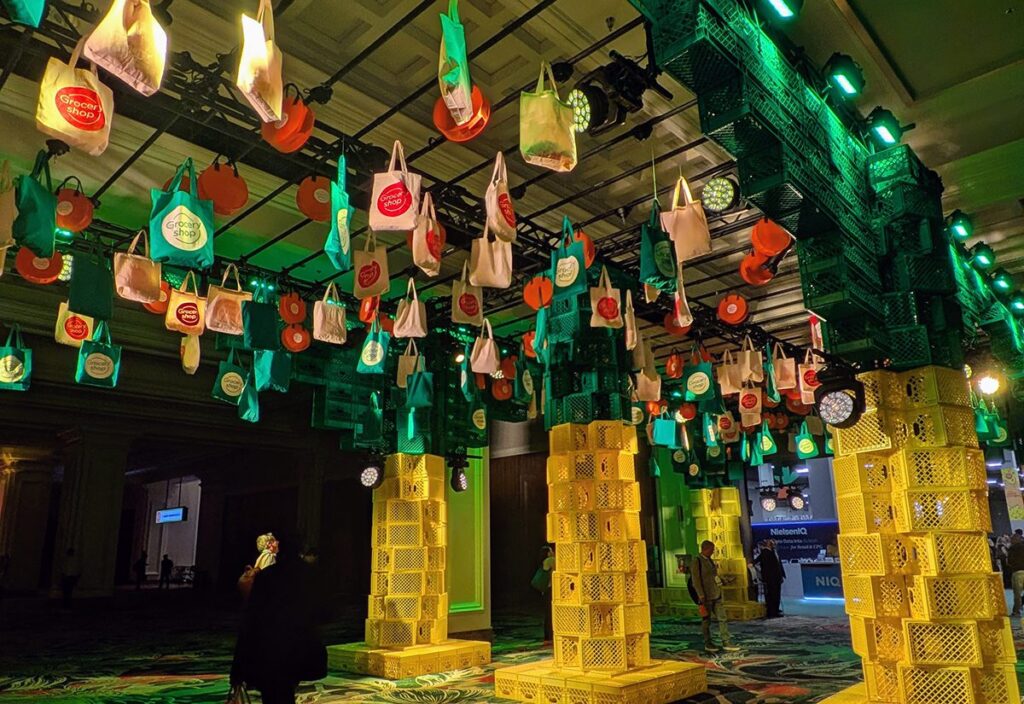
Mark Snyder can empathize with Barack Obama, another leader who has taken over in a really tough time.
Except Obama didn’t have to worry about Black Friday.
Obama took office just as banks and brokerage houses were imploding, in an economy more challenging than any since FDR’s day. Snyder made the jump from travel and hospitality into the chief marketing job at discount retailer Kmart last September, with home creation at an all-time low and consumer confidence in freefall.
“I really respect the way Obama has been able to rally people around change,” says Snyder. “He’s taking people back to the potential of America. Joining Kmart, I knew that was going to be my biggest challenge. Getting the internal constituency to rally around the brand, and rebuilding pride about the role we play in people’s lives, is essential to getting the brand back on the right track.”
Seven months after Snyder’s arrival, nobody’s claiming that Kmart is back on the rails. But the chain has avoided breaking, and Snyder thinks it can hold its own against category rivals Walmart and Target.
Kmart’s recent history hasn’t exactly helped put the 47-year-old brand back on the rails: a Chapter 11 filing in 2002; the closure of about 600 stores and the layoff of about 57,000 employees before re-emerging from bankruptcy the following year; the acquisition of Sears Roebuck in 2004; plans to replace the chain’s down-at-heels outlets (now about 1,400 nationwide) with fresher stores placed on hold; and same-store sales declines in 2007 and 2008.
Just the same, Snyder says his previous expertise has equipped him to rebuild confidence in a long-time brand. Prior to joining the company, he spent five years with the Intercontinental Group’s Holiday Inn brand family, most recently as senior vice president of global brand management. Before that, he helped define the Embassy Suites chain and plot a new position for the Harrah’s brand.
“I knew coming in that Kmart was struggling under some pretty heavy negative perceptions, and that we were going to have to define what Kmart was compared to its competitive set,” says Snyder. “If you don’t help people understand what a legacy brand like Kmart is today, they’re going to rely on the perceptions they have from 30 or 40 years ago.”
KMART SMART
Through consumer research and focus groups, Snyder and his marketing team arrived at a distillation of what they thought the Kmart brand identity needed to be. The chain needed to find room between Walmart’s strong value-priced play and Target’s cheap chic. Snyder and his team thought they saw a niche with “ Kmart smart,” an appeal aimed at shoppers who want value but are savvy enough to get those savings with style.
“Walmart’s got the reputation as the low-price leader, always,” he says. “Target was the first mass-merchant to step up and claim to be the trendiest. We decided Kmart could own the identity as the smartest.”
In product selection, that means being sure always to offer “unexpected quality” for low prices, according to Snyder. For example, during the holidays, the chain offered 100% cashmere sweaters for $40 dollars, and 800-thread-count sheets for discount prices.

“You just won’t find 100% cashmere at discount stores, and definitely not at a Kmart price,” he says. “And at most mass merchants, high thread count means a high price too.”
Kmart also has access to unique brands and product lines. The company has long-running relationships with the apparel and home furnishing lines associated with actress Jaclyn Smith and domestic diva Martha Stewart; built the Joe Boxer brand in men’s underwear; and established a mom following for its Route 66 store brand in kids’ clothes. The merger with Sears also brought Craftsman tools, Kenmore appliances and DieHard batteries into the Kmart pipeline, and about 300 of the stores now sell those marquee brands.
The brand will continue its emphasis on offering quality apparel at affordable prices. Last May, that effort led to Kmart’s online “Style Showoff Contest” to find a real-life fashion ambassador. More recently, the chain has taken its shoe business in-house, producing a line of low-priced basketball shoes created by New York Knicks forward Al Harrington, as well as numerous women’s styles.
Finally, Kmart is going to lengths to bulk up merchandise with no-cost add-ons: everything from throwing in a Disney princess teapot with a purchase of a “Little Mermaid” video, to a free custom belt with jeans from Kmart’s in-house designers.
“Never underestimate the power of free,” Snyder says.
Continue on Page 2

OLD IS NEW
One of the best brand-building moves Snyder and his team made turned out to be no move at all.
Unlike rival Walmart, Kmart had never abolished the layaway shopping option that was almost a retail staple back in 1962, when the chain was founded. Focus group research told the retailer that credit-squeezed shoppers were likely to want the layaway option as a budgeting tool during the holiday shopping season. Under the plan, shoppers can put items in layaway for eight weeks, paying a 10% down payment and then a quarter of the cost every two weeks until the item is bought.
So Kmart took what seemed an obsolete ’50s relic and turned it into one focus of its holiday campaigns. Kmart agency Draftfcb Chicago featured the hold policy in broadcast spots, print ads in women’s and lifestyle magazines, and in online display ads on money-tips Web sites.
“We chose [layaway] to be the centerpiece of the holiday campaign because we owned it,” Snyder says. “Our research told us our shopper was going to make the best budget choices she could during this recession, and she used it like crazy.” Layaway sales for Q4 2008 were up $120 million over the same time the year before.
The chain is continuing to stress layaway in the spring quarter for things like Easter clothing and outdoor furniture. “It’s a smart way to get the things a family needs without running up a bunch of credit-card debt and finance charges,” Snyder points out.
STAR VEHICLES
Another marketing adjustment begun under Snyder’s predecessor, former CMO Bill Stewart, is continuing to make its effect felt: highly integrated chainwide promotional campaigns around entertainment properties. Where before these were largely restricted to in-store activations, now these campaigns reach to print ads, circulars, out-of-store promotions and contests.
Kmart is often taking on the role of official promotional partner, not simply selling licensed merchandise. For example, the store was the “Official Batman Headquarters” for last year’s “Dark Knight” release and partnered with candy maker Reese’s to hand out a free ticket to the movie with the purchase of three bags of Reese’s items. Visitors to the Kmart.com Web site could also download Batman wallpapers.
In March, Kmart climbed into the ring with World Wrestling Entertainment for the 25th anniversary of Wrestlemania. Pop-up stores within Kmart units offered licensed products — from WWE apparel and bedding to toys and games. And customers who spent more than $50 on those items got a $10 discount on the April 5 pay-per-view broadcast of the slugfest.
“We found our customer has a much greater affinity for bonding with entertainment characters than their Sears counterparts, whether it’s Nickelodeon, Disney, ‘The Dark Knight’ or the WWE,” he says. “It’s a concerted effort on our part to take the elements of those properties and bring them in-store with merchandise that gives us a tremendous take-up from our target customer.” The chain will run another big promotion around the “Transformers” sequel due out in late June.
INTERNET INTENTIONS
With the holiday shopping season over, Snyder and Kmart are now taking the time to find the right way to engage those frugalistas online. The chain is now considering building a site that will both aggregate money-saving tips and also give shoppers a chance to engage in conversations with the brand and with one another.
In some ways, Kmart’s still at the shallow end of the interactive learning curve. Its Facebook page seems to be largely a communications tool for store employees. And an experiment with social media incurred blogger wrath last December. Working with Izea (formerly PayPerPost), Kmart gave $500 gift cards to six influential bloggers and sent them on a shopping spree, asking only that they report on their Kmart experience. The bloggers disclosed the gift and were not required to be positive in their comments. They also received a second gift card to give away to one of their blog readers in a contest.
The social-media effort got strong buzz, with 2,000 contest entries in the six blogs and a reach of about 500,000 people by Dec. 5. But that attention quickly turned to a flood of Twitter criticism by bloggers who thought Kmart’s effort smacked of paying for good blog posts.
Snyder chalks it up to experience. “We are very much about testing and learning, and this was just one approach we took to see what kind of measurable indication we could get from social media. We got some learning from it, and we’ll build on that learning.”
Admittedly, none of these marketing tactics will do Kmart as much good as a strong rebound in consumer confidence or housing starts. They also won’t make the aisles wider or the stores newer. But Snyder says the chain’s store ops teams have stepped up efforts to make basic improvements in neatness and ambiance, and that the frugalista who is Kmart’s core customer will trade a few décor niceties for a high-quality product at a good price.
“She wants the store to be clean and bright, easy to navigate, well stocked, and populated with service people who are willing to help,” he says. “But she’s not expecting the Hanging Gardens of Babylon. The value proposition is compelling enough for her.”
KMART’S STORY
so far
| 1962 | Sixty-year-old chain store S.S. Kresge opens first Kmart discount department store in a suburb of Detroit. Seventeen other Kmart stores open the same year. |
| 1966 | Founder Sebastian S. Kresge dies at age 99. |
| 1966 | Sales top $1 billion mark for the first time. Number of stores climbs to 915, including 162 Kmart stores. |
| 1977 | In 1976, sales at Kmart stores accounted for 94.5% of Kresge’s domestic consolidated sales. Name changed to “Kmart” to reflect that shift. |
| 1981 | 2,000th Kmart store opens. At year end, there were 2,055 Kmart stores in the U.S., Canada and Puerto Rico. |
| 1985 | Jaclyn Smith apparel collection launched: deal expanded to home decor in 2008. |
| 1987 | Kmart sells off remaining Kresge U.S. stores to McCrory Corp. |
| 1987 | Kmart introduces Martha Stewart, entertainment and lifestyle spokeswoman and consultant. |
| 1997 | Kmart launches Martha Stewart Everyday line of bed and bath fashions, and complementary paint line. |
| 2002 | Kmart files for Chapter 11 bankruptcy protection. At the time, the company had 2,114 stores. The bankruptcy led to the closing of about 600 stores and the termination of 57,000 employees. |
| 2003 | Kmart exits Chapter 11 bankruptcy protection as Kmart Holding Corp. |
| 2004 | Kmart combines with Sears, Roebuck & Co. in an $11 billion deal that creates Sears Holdings Corp. |



